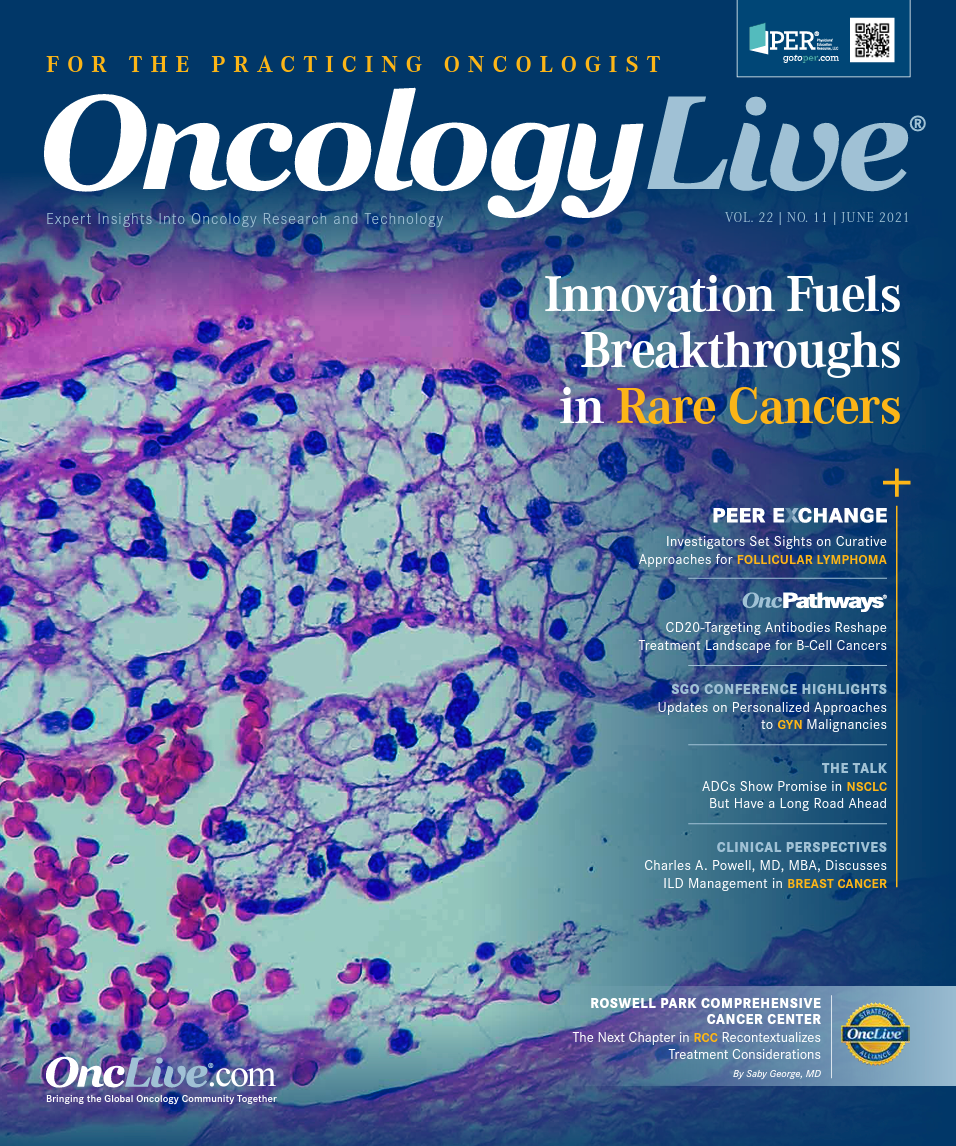Loncastuximab Tesirine Provides Alternative for Broad Range of Patients With DLBCL
Loncastuximab tesirine-lpyl (Zynlonta) exhibited significant clinical activity, including impressive response rates with tolerable safety, as a single agent in adult patients with relapsed/refractory large B-cell lymphoma that failed prior established therapies.
Paolo F. Caimi, MD

Loncastuximab tesirine-lpyl (Zynlonta) exhibited significant clinical activity, including impressive response rates with tolerable safety, as a single agent in adult patients with relapsed/refractory large B-cell lymphoma that failed prior established therapies.
On April 23, 2021, the FDA granted accelerated approval to the CD19directed antibody and alkylating agent conjugate for the treatment of adult patients with relapsed/refractory large B-cell lymphoma, including diffuse large B-cell lymphoma (DLBCL) not otherwise specified, DLBCL arising from low-grade lymphoma, and high-grade B-cell lymphoma, following 2 or more lines of systemic therapy.1
The decision was based on data from the single-arm phase 2 LOTIS-2 trial (NCT03589469), in which the agent elicited an overall response rate (ORR) of 48.3% (95% CI, 39.9%-56.7%) in 145 patients with DLBCL. This included a complete response (CR) rate of 24.1% (95% CI, 17.4%-31.9%) and a median duration of response (DOR) of 10.3 months (95% CI, 6.9-not estimable).2
In an interview with OncLive®, Paolo F. Caimi, MD, an associate professor of medicine in the Division of Hematology and Oncology at Case Comprehensive Cancer Center at Case Western Reserve University and medical director of the Clinical Trials Unit at University Hospitals Seidman Cancer Center, both in Cleveland, Ohio, discussed what lies ahead for loncastuximab tesirine and how it fits into the rapidly changing treatment landscape of DLBCL.
OncLive: Please provide an overview of the patient population in the phase 2 LOTIS-2 study.
Caimi: This trial was focused on relapsed/refractory DLBCL and included adult patients who had at least 2 prior lines of therapy. It included not only those with regular DLBCL but also patients with double-hit lymphoma, which is termed high-grade B-cell lymphoma with MYC and BCL2 and/or BCL6 rearrangements, as well as those who had primary mediastinal B-cell lymphoma. Patients had to have acceptable functional and hematologic status and had to be within normal limits in terms of renal function and liver function. They also had to have a positive CD19 expression as demonstrated by biopsy if they had undergone prior chimeric antigen receptor (CAR) T-cell therapy; however, patients with prior CAR T-cell therapy were not excluded. The study did exclude patients with bulky disease.
What was noteworthy about the efficacy data that led to the approval?
Loncastuximab tesirine was active with an ORR of 48% and a CR rate of 24%. It is notable that as a single agent, it elicited response rates that other agents [did not] achieve in combination. Secondly, there was a good DOR of over 10 months, and the DOR was not reached for those who had a CR. In addition, the population was high risk. We presented at [the 62nd American Society of Hematology Annual Meeting and Exposition], and we are going to present a subgroup analysis [at the 2021 American Society of Clinical Oncology Virtual Scientific Program] showing how different risk factors didn’t affect how the drug worked.
What adverse effects do clinicians need to be aware of when prescribing this drug?
Paolo F. Caimi, MD In general, loncastuximab tesirine is a well-tolerated drug. Compared with other drugs that are approved [in this setting], the adverse effects are somewhat different. Loncastuximab tesirine has described elevations of γ-glutamyltransferase as a frequent adverse effect. [Patients also experienced] mild to moderate hematologic toxicity. Additionally, there were portions of populations [with lymphoma] who had thrombocytopenia, approximately 18%, neutropenia in approximately 26%, and there were occasional cases with fluid retention and edema.
Photosensitivity including a rash or other skin damage with exposure to the sun [was also observed]. Practitioners need to monitor [results of] liver function tests and hematologic function tests, and change or adjust dosing for patients who have fluid retention. I also advise patients to stay away from the sun as much as possible, use sunblock, and [wear] additional clothing.
How does this approval advance the DLBCL treatment paradigm?
We’ve seen several new agents approved for DLBCL in the past 24 months, including some CAR T-cell therapies. This is the first antibody immunoconjugate drug targeting CD19 that is approved as an off-the-shelf agent, that is active as a single agent, and that is well tolerated. In addition, loncastuximab tesirine really doesn’t cause neuropathy, which is a common [adverse effect] with other agents.
With loncastuximab tesirine we have another drug that has single-agent activity and has the potential for combinations—[I hope] this will be studied. Loncastuximab tesirine has significant value in the treatment of DLBCL, [particularly for those] with severe neuropathy, those who may not tolerate CAR T-cell therapy, or those you may think will need treatment relatively quickly.
What are the next steps for this agent?
[Next steps for loncastuximab tesirine include] delineating the activity as a single agent, which will be important. Single-agent activity promises the potential for combination, and this is something that I think will be studied in the near future to see whether we can elicit further activity by using combinations with other new agents, particularly targeted ones. Also, for loncastuximab tesirine in general, as we’ve seen with other anti-CD19 with CAR T-cell therapies, the potential for activity in other lymphoma and B-cell lymphoma subtypes is significant. Further examination of its role for patients with mantle cell lymphoma [in combination with ibrutinib (Imbruvica) in a phase 1/2 trial (NCT03684694)] and follicular lymphoma will be relevant.
References
- FDA grants accelerated approval to loncastuximab tesirine-lpyl for large B-cell lymphoma. FDA. April 23, 2021. Accessed May 12, 2021. https://www.fda.gov/drugs/fda-grants-accelerated-approval-loncastuximab-tesirine-lpyl-large-b-cell-lymphoma
- Zynlonta. Prescribing information. ADC Therapeutics; 2021. Accessed May 12, 2021. https:// www.accessdata.fda.gov/drugsatfda_docs/label/2021/761196s000lbl.pdf




